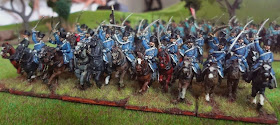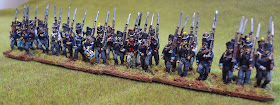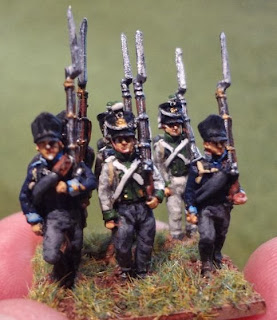Everyone who follows my blog will be aware of the situation of our family in Tacloban. I have been trying to get my head straightened out with hobby, work and life related things instead of thinking to much about what has happened. Progress with my own troops has been painfully slow. However thankfully Craig has been able to paint up some new Prussian cavalry regiments and has put together a post to show how they turned out. They look top class to me!!!
Dragoon Brigade
As Paul has done such a cracking job with his dragoons, I thought I would share mine so you can see what second place looks like, or if not second place, what your average punter (as opposed to a Scottish miniature-painting grand master) can achieve. The cavalry reserve for Yorck’s Corps is composed of three brigades. The first brigade that I put together was the dragoon brigade, under Colonel Graf Henckel von Donnersmarck. The brigade is composed of two regiments, 1st West Prussian dragoons, and 3rd Lithuanian dragoons.
Dragoon brigade
The brigade fought in a number of the major actions of the Autumn campaign: Katzbach; Goldberg; Wartenburg; and Leipzig. It was involved in some of the intense action around Goldberg in which it rescued elements of 8 Brigade which had been cut off by French cavalry and was withdrawing under heavy pressure.
During the 1812 campaign, two squadrons from each of these regiments were combined to form the 1st combined dragoon regiment which fought as part of Yorck’s Corps under McDonald on the northern flank of the Grande Armee’s advance. After the treaty of Tauroggen they were reformed as whole regiments and brigaded together under Yorck.
Lithuanian dragoons
The first AB cavalry I painted was the 3rd Lithuanian dragoon regiment. It wears the standard dragoon uniform of litewka (long coat) over grey overalls, with white belts and covered shako. Facing colour is red. The colour of the litewka was something I pondered for a while, as Osprey and other sources seemed to all differ slightly. I was not until I came across a photograph of some Prussian re-enactors and a picture of a museum exhibit that I plumped for the sky blue. I used a flat blue undercoat, with a deep blue mid-coat, highlighted with pale blue. I have been satisfied with the result.
Lithuanian dragoons close-up
Under the August 1813 orbat I am using, this is a pretty strong regiment, of 32 figures, in 4 squadrons of 8 figures each, plus a jager squadron of 8 figures. I have had some reasonable performances from this unit on the table, although like most Napoleonic cavalry they tend to have as much effect threatening to do something, as actually doing it. The commander, Major von Platen (nicknamed Crazy Platen) was made (more?) famous by the action of his bugler in dispatching a French cavalryman with his bugle. Paul has done a superb vignette of this.
As per the infantry, freiwillinge volunteer jager detachments were part of each regular unit, with the size varying according to the popularity of the regiment. The Lithuanian dragoons were reasonably popular, and so were able to field an entire squadron.
Lithuanian dragoon jager squadron
For each unit painted, I also provide a casualty marker in the appropriate uniform. Its presence adjacent to a unit means that the unit has taken casualties, and the casualty sheet should be checked before making calculations that include unit strength as a factor.
Casualty marker
The second unit in the brigade 1st West Prussian dragoons. It wears the standard dragoon uniform with a mid-blue litewka faced white and covered shako. This unit is slightly weaker, at 24 figures, plus a single jager figure. This probably reflects that in August 1813 much of its recruiting areas in West Prussia were still under French control. This unit has also given good performance on the table, breaking an Italian square during a notable game in the back of Eureka Miniatures.
West Prussian dragoons
West Prussian dragoons close-up
The command stand that I have created for the brigade follows my practice of having a group which reflects the variety of units in the brigade. This group represents Oberst Graf Henckel von Donnersmark depicted using the AB Blucher figure suitably painted as a Prussian commander, an officer from 1st West Prussians, and a bugler from the Lithuanians.
Brigade command stand
Excellent Craig and I'm really looking forward to your next regiment. Something a wee bit special for us 1813 Prussian fans!






























